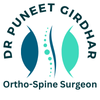What exactly is scoliosis?
Scoliosis is a descriptive term, not a disease. It refers to a lateral (side-to-side) curve in the spinal column that is abnormal. The vertebrae of a healthy spine should form a straight line when viewed from the back, but in someone with scoliosis, the spine looks more like a “S” or a “C” than a “I.” This scoliosis may cause additional rotation.
Scoliosis: What Causes It?
Scoliosis can be caused by a variety of factors, including congenital spine deformities (those that occur at birth and are either inherited or caused by the environment), genetic conditions, neuromuscular problems, unequal limb lengths, and osteoporosis. Adults can develop scoliosis as a result of age-related wear and tear.
Cerebral palsy, spina bifida, muscular dystrophy, spinal muscular atrophy, and tumors are some of the other causes of scoliosis. However, more than 80% of scoliosis cases have no known cause.
Scoliosis Types
- Degenerative scoliosis — This type of scoliosis is characterized by arthritis and spine degeneration. It usually gets worse as you get older.
- Congenital scoliosis – Congenital scoliosis is defined as a curvature of the spine caused by malformations of the vertebral elements. Given the complexity of the embryological process, it’s amazing that the spine and spinal column ever form correctly. The majority of this development occurs between the third and sixth weeks of pregnancy (after conception). Despite the risk of error, congenital malformations are extremely rare.
- Adolescent idiopathic scoliosis – This is the most common type of scoliosis in North America, affecting up to 5.2% of the population. 1 It is frequently seen during or after an adolescent growth spurt. To diagnose and treat idiopathic scoliosis, a physician must first rule out all other causes of scoliosis. The majority of idiopathic curves that appear in adolescence are painless and gradual, have a typical curve pattern (e.g., a right thoracic curve), and the neurological exam is normal. Females are far more likely to develop idiopathic scoliosis than males.
- Neuromuscular scoliosis – This term refers to the curvature of the spine in children who have a neurological disorder. Cerebral palsy, spina bifida, muscular dystrophies, spinal cord injuries, and other conditions fall into this category.
What Are Spondylolisthesis Symptoms?
Some injuries or trauma, such as falling down the stairs or slipping, can sometimes lead to pain that persists for several months—chronic pain. When conservative therapies like medication and physical therapy don’t help to relieve the pain, there are other treatment options to consider, such as back surgery and chronic pain therapies. Talk to your doctor if your pain doesn’t seem to go away.
The degree of vertebral slippage has no direct relationship to the amount of pain a person will feel. Some people with spondylolisthesis will link the onset of their symptoms to an injury.
A person with spondylolisthesis may experience leg pain in addition to back pain. In this case, there may be associated narrowing of the area where the nerves exit the spinal canal, causing irritation of a nerve root.
How is it identified?
Many people who have spondylolisthesis have vague symptoms and little visible deformity. The tightness of the hamstring muscles in the legs is frequently the first physical sign of spondylolisthesis.
Plain lumbar spine x-rays are initially best for diagnosing spondylolysis or spondylolisthesis. Spondylolisthesis is most visible on lateral and oblique spine views, but in some cases, specialised imaging studies such as a bone scan or CT scan (CAT scan) are required to make the diagnosis. Dyplastic pars patients have an elongated interarticular region as well as altered pedicles. A CT scan is usually the best way to see this.
The amount that one vertebral body has slipped forward on another is used to grade spondylolisthesis:
Grade I – Less than 25% slippage
Grade II – Between 25% and 50% slip
Grade III – Between 50% and 75% slip
Grade IV – More than 75% percent slip
Grade V – The upper vertebral body has slid completely forward off the front of the lower vertebral body. This is a very rare condition known as spondyloptosis
Diagnosis Differential
The discovery of a pars defect on a lateral x-ray or CT scan confirms the diagnosis of spondylolysis, and the forward position of one vertebral body on another confirms the diagnosis of spondylolisthesis
Views of the lumbar spine in flexion and extension may aid in determining the presence of spine instability (abnormal excessive motion between vertebrae upon movement). This movement could be a significant contributor to the pain you’re feeling and vital to the treatment plan you’re working on.
How is it handled?
Rest, followed by trunk and abdominal strengthening exercises, is the most common non-surgical treatment for spondylolysis and spondylolisthesis. A physical therapist can often help you get back on your feet and teach you how to do these exercises correctly without exacerbating your symptoms. If your leg pain is severe, you can also take an anti-inflammatory medication. Braces are rarely required, but they may be beneficial in reducing your symptoms. Injections of anti-inflammatory cortisol may also be beneficial.
Surgery to repair the defect in the pars interarticularis is only required for people with spondylolysis after non-surgical measures such as physical therapy and exercises have failed to relieve symptoms. Surgery may be used to directly repair the pars defect in younger people without a slip; in older people or those with some degree of instability, a spinal fusion may be required. If there is slippage, the two main goals are to unpin the nerves and to stabilize the spine internally. It is also possible to return things to normal alignment.
